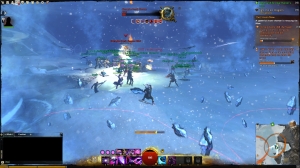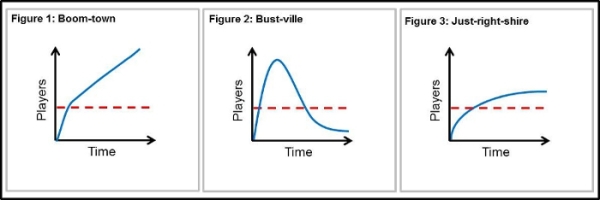Archive
Dynamic quest content in 2013: GW2, FFXIV, and WoW
Late last year I wrote a bit about my hopes for dynamic quest content in MMOs. Dynamic quest content was a promise to break away from a fixed linear content model where players are pushed along one or — if you were lucky — a few fixed questing tracks in a game. Once those were complete, players mostly had to wait until new content was released or perform some repetitive tasks, usually in the form of daily quests. This is killer for games whose entire existence is based on a persistent world. Several games have incorporated dynamic content into their play models, so I thought it was worth taking a look back at my experiences with how they implemented this potentially ground-breaking technology.
Guild Wars 2
 Guild Wars 2 was the first game to try and incorporate dynamic content. Early on, running around in new zones was exciting. Sure, every now and again you’d run into the same events, but overall it felt like every time you entered a zone, you’d end up having a slightly different gaming experience. That was a huge plus, and I think it ultimately gave the game some good legs for both myself and my wife. The problem was that even though the event chains were extensive, they weren’t random. In fact, they were scripted along relatively narrow paths. And true to form, players found a way to optimize the patterns. I don’t think either of us is entirely sure when the change happened, but over time as players started figuring out patterns in zones and ArenaNet started adding more rewards for dynamic events, doing those events just stopped being fun. The champion farm was born. Masses of players would run in circles around zones knocking off supposedly challenging mobs like they were nothing to get some great rewards. And they can get nasty about it if anyone messes up the cycle. This was particularly bad in low level zones where new players can be exposed to that as some of their first gaming experiences. All the complexity of the dynamic events boiled down into a circuit course with a mob of players that trivialized the encounters.
Guild Wars 2 was the first game to try and incorporate dynamic content. Early on, running around in new zones was exciting. Sure, every now and again you’d run into the same events, but overall it felt like every time you entered a zone, you’d end up having a slightly different gaming experience. That was a huge plus, and I think it ultimately gave the game some good legs for both myself and my wife. The problem was that even though the event chains were extensive, they weren’t random. In fact, they were scripted along relatively narrow paths. And true to form, players found a way to optimize the patterns. I don’t think either of us is entirely sure when the change happened, but over time as players started figuring out patterns in zones and ArenaNet started adding more rewards for dynamic events, doing those events just stopped being fun. The champion farm was born. Masses of players would run in circles around zones knocking off supposedly challenging mobs like they were nothing to get some great rewards. And they can get nasty about it if anyone messes up the cycle. This was particularly bad in low level zones where new players can be exposed to that as some of their first gaming experiences. All the complexity of the dynamic events boiled down into a circuit course with a mob of players that trivialized the encounters.
Final Fantasy XIV: A Realm Reborn
The amazing thing is that even if the model the Guild Wars 2 implemented wasn’t perfect, it’s started to permeate into other MMO contenders. Since I had given Final Fantasy XIV a try when it was first released, I decided to take advantage of my free month. I’d not really followed the games refurbishment, but I was particularly surprised to find out about the FATE system. One of friends told me about the FFXIV’s dynamic quests before I jumped in: “You have your story quests as well that are specific to you and your personal progression through the game, you have class quests for all the different classes, you have FATEs which are basically like guild wars style events, in fact almost EXACTLY the same events in some cases.”
I’m not going to be quite so favorable as to say FFXIVs FATEs were on par with Guild War 2’s dynamic quests, but they definitely had a lot of similarities. Indicators on the mini-map alerted players in the region to crises that demand that players flock from all around. They can last for for up to 15 minutes and have even less impact on the game world. But they did make running around at least slightly more variable. Unlike GW2 dynamic events, however, players are incentivized to participate in FATES thanks to their experience rewards. There were only enough story quests to level your main class so FATE circuits became one of the primary mechanisms for players to level up alternate classes. This was annoying because as with GW2, the events seemed to not scale terribly well past a certain threshold of players. Ultimately, I didn’t play the game for more than a month or so. I can’t say that the FATEs were the single reason, but they definitely didn’t help.
World of Warcraft: Mists of Pandaria
Which brings me to my most current gaming experience with dynamic events: World of Warcraft’s Timeless Isle. I’d stopped played World of Warcraft about a year ago, but the recent announcement for many changes to game in the next expansion at Blizzcon prompted a lot of my old friends to return to the game. We’re going to see if Blizzard’s new “it’s more fun to play with friends” approach to design was as genuine as it seemed listening to them talk about it. To my surprise, I found out that they’d been slowly adopting dynamic event content into their game as well. Thunder Isle in patch 5.3 had a few small dynamic events and the Timeless Isle in patch 5.4 did away completely with scripted daily quests in favor of small little events on the Timeless Isle.
 When I first got to the Timeless Isle, I couldn’t help but notice was a few players seemingly running in a circuit. It didn’t take long to figure out that there are a relatively fixed number of possible events and most people just run around looking for them. As with FFXIV and GW2, Blizzard opted to place some small call-outs on the map to alert players to events and rare bosses spawning on the island. Players also tend to call out when then events are up, resulting in mobs of players converging on whatever events happen to be active, just like the champion farms of Guild Wars 2. Overall, there’s a decent range of larger events and smaller events on the island, but the number is so small that it becomes fairly repetitive quickly. Blizzard’s announced there will be more content like this in Warlords of Draenor, so it’ll be interesting to see what they’ve learned and if they can expand on what seems like an growing experiment for the developers.
When I first got to the Timeless Isle, I couldn’t help but notice was a few players seemingly running in a circuit. It didn’t take long to figure out that there are a relatively fixed number of possible events and most people just run around looking for them. As with FFXIV and GW2, Blizzard opted to place some small call-outs on the map to alert players to events and rare bosses spawning on the island. Players also tend to call out when then events are up, resulting in mobs of players converging on whatever events happen to be active, just like the champion farms of Guild Wars 2. Overall, there’s a decent range of larger events and smaller events on the island, but the number is so small that it becomes fairly repetitive quickly. Blizzard’s announced there will be more content like this in Warlords of Draenor, so it’ll be interesting to see what they’ve learned and if they can expand on what seems like an growing experiment for the developers.
Observations
Based on the three games, I’ve come up with a few general observations about what I’d like to see in the next generation of dynamic quest content.
- Most dynamic quests feel “right” for about 2-10 people, beyond that even if monsters scale in health based on the number of players the social dynamic seems to crumble. Announcing the quests to crowded zones tends to draw too many people; it may be worth having several pools of events that can happen in a given zone based on how many people are around (e.g. if a zone is crowded, mostly large scale events designed to accommodate that many occur).
- Cause and effect is still too predictable, and thus exploitable, by the general player base. Most zones seem to have too few events that get cycled through. Logging in results in less of a question of “what will I experience today?” than “when will I experience these events?” It’d be nice if the pool of possible events was large enough and variable enough that you might only see a given event once a week or so.
- Dynamic content can tend to feel disconnected due to the events being somewhat isolated. Responding to individual crisis after individual crisis can feel a bit futile. WoW and Guild Wars have implemented zone wide rewards for participating in certain events in a zone, but these still fall a bit short of a compelling reason why a character is running around after a point. It’d be nice if maybe the game could string a few events together to create individual meta-objectives for players.
- Dynamic content still mostly only impacts the game world locally. In the best implementations, infrastructure and player services can be disrupted, but it’s almost always completely temporary and usually only a minor nuisance. In the worst, the events do absolutely nothing to affect the game. Ideally, it’d be better if a dynamic event affected a wider area. For example, a conflict a few zones over could noticeably affect prices or availability of goods to incentivize players to spread out and also give the world a larger sense of connectivity.
The introduction of dynamic quest content has definitely left a mark on the MMO genre and is becoming a fixture with new, redone, and old games. I’ve not been shy about how excited I am that these games are moving beyond linear content; but I’m also coming to realize that sometimes theory can only take you far. I don’t know yet what the future of dynamic content is going to be in MMOs, but it almost certainly is not yet mature. My hope is that someone can find a way to keep it fresh enough that we can avoid the compulsion to run around in circles waiting for random stimuli. I’d rather wander and be pleasantly surprised, than feel like I’m piling in for the morning commute.
End-Game Primacy: Part 1
Part 1: Exploring Principles:
To suggest that I have a better way to build an MMO is to suggest that there is a problem with the current model. That’s not being entirely fair because there are plenty of good MMOs out there right now. However, it has been my experience as a player that innovation seems to have slowed as more developers choose to replicate the same MMO models across new franchises rather than take big risks of new kinds of MMO game play. My theory is meant to be an alternative, and I hope justification for someone to build this concept. I’m going to start with what I believe needs to be the ultimate goal of any MMO and then work backwards on how I think there is a better way to reach that goal that not only makes a better game for players, but also meets the business needs of developers and producers.
1) Successful MMOs need player volume to make money. Massively multi-player online games are inherently expensive to produce and maintain. From a business model standpoint, this means that the game needs to attract enough players for a long enough period of time to recoup initial development costs, provide future maintenance and development costs, and also make a reasonable profit for the developer and producer. It doesn’t matter if the business model is free to play with micro-transactions or subscription based. A consistent player volume is required for both. This need for money is a hard truth to swallow for those most passionate about these games (myself include) because we tend to idealize the art form. But a healthy player population is not only good for business, it’s also good for game play too (more on that in a moment), which is a goal even the most doe-eyed idealist gamer can get behind.
2) A stable population is a function of player retention . To reach the idealized population sweet spot where the game world is bringing in enough money to meet the above objectives, players need to be retained over a period of time. In an ideal world, which I’m going to refer to as “Boom-town” (figure 1), players will opt into the game world and choose to never opt out. This would result in near continuous growth as more and more players try the game. The second scenario, which I’m calling “Bust-ville” (figure 2), shows what happens with many MMOs these days. Players flock to the new game, but their average retention time isn’t long enough to let new players replenish their ranks. The population falls below the theoretical “healthy population” line and fails to make enough money or keep game play interesting enough to attract new players. The last scenario, or “Just-right-shire” (figure 3), is the most realistic goal. The initial spike of players is high enough to get above the healthy population line, and average player retention time is long enough that the population never drops below that line. The game reaches a state of equilibrium or steady sustainable growth.
3) Player retention is tied to content relevant to a players interest. If content is relevant to a players interest, it should theoretically be fun for the player. As long as that content exists, the player should be retained. It sounds simple, but it’s honestly where this gets wildly complicated. Not surprisingly, fun is different for different people. Some players will be attracted to story, others to exploration, others to combat with other players. Most will move back and forth between all of these elements at various times during their retention. There simply is not enough time and resources to make content to appeal to everyone at all times. Even if a game developer decides to focus on appealing to a narrow population group, players consume this content far faster than developers can make it. Consider the quote below from Ralph Koster:
If you write a static story (or indeed include any static element) in your game, everyone in the world will know how it ends in a matter of days. Mathematically, it is not possible for a design team to create stories fast enough to supply everyone playing. This is the traditional approach to this sort of game nonetheless. You can try a sim-style game which doesn’t supply stories but instead supplies freedom to make them. This is a lot harder and arguably has never been done successfully.
Koster is specifically talking about stories, but this holds true for if you substitute any kind of content for stories. Even the most successful MMO development teams today struggle content fast enough to keep their players from consuming it too quickly. At best, they skirt keeping their populations above the healthy line with injections of content as expansions. At worst, they experience Bust-ville, where their initial content release and subsequent content production is too slow to keep player retention up long enough to see population stability. Repetition and pseudo-random elements in the static content can alleviate this somewhat, but these are band-aids to the larger issue. Other variables like brand loyalty or lack of competitors can also extend the life of this content, but they still cannot compete with new content. Even the best roller coaster in the world gets boring after the one hundred forty-seventh time for all but the most extreme roller coaster enthusiasts.
Continue reading more Part 2: Building the Theory or head back to the Introduction to navigate from there.
Quest Creep
I’ve been trying to do more running lately. While it’s not directly related the Quest, it ends up being important because my mind decides to go into rapid fire idea generation mode while out on these runs. The skeleton game ideas I’ve been tossing around for awhile really need fleshing out and these runs end up kick-starting that process. I get back to the house physically exhausted and mentally charged, sit down in front of the keyboard while I try to cool off, and start digging for ways to bring my ideas to life. These deep dives into the independent gaming communities of the web end up being as frustrating and humbling as they are enlightening, mostly because they reveal how much I still have to learn and how far away I am from reaching the goal of a playable demo for these ideas.
I never expected game design and development to be easy; on the contrary, I knew it was going to be demanding. Where I seem to have miscalculated was where I though I might be able to cut corners. In many ways, I’ve often found myself searching for a few hours for a faster / easier / simpler way to do something only to realize that I would have probably gotten more done by devoting those few hours to just learning something more elementary. For instance, I spent the better part of today searching for open source gaming engines, trying to find one that would let me jump right in. Naively, I thought that someone would have spent the time building such a tool, but in a lot of ways, that’s like expecting someone to build a program to automatically make money and then give it away for free. Still, I found several tools that attempted to give me what I wanted, but the tools I found were either incomplete or too inflexible to do what I wanted them to do. That’s not meant as a point of criticism of independent developers, but rather a realization that I was going to have to learn to make more of those tools and adjustments myself.
At the end of the day, I think it’s important for me to keep in mind that I’m just one person. Anything worth designing and developing is either going to take a long time if I insist on doing it myself or I’m going to need a team at some point. More importantly, until I do get a team, I need to have a more rational expectation of what I can accomplish in a given week and stop chasing ideas that are outside of that scope. It’s humbling to admit that, but short of cutting out the other things in my life I enjoy (like actually playing games) I just don’t see how I’ll get anything done otherwise.


